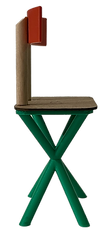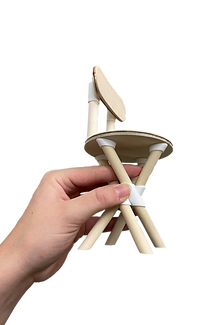
My role:
-Industrial Designer
-Fabrication Specialist
-Sustainability Researcher
-Accessibility Designer
-Packaging/Systems
Designer
Objectives:
Make a chair that uses recycled material, flat-packs, and requires no tooling for the consumer to assemble
Tools:
-Illustrator
-Indesign
-Rhino
-BambuLab
-Keyshot
Timeline:
Fall 24'
10 weeks
How might I create a chair that is flatpackabe to reduce immessions, able to be assembled with no tooling to inclrese accessibility, and use recycled materials to help reduce waste?
How might I create a sustaniable chair buy reducting emmsions by making it flat packable and aloowing it to be made of recycled materials?
How might I design a chair that values sustainability by being flat packable while prioritizing users of all abilities during assembly processes?
Flat packable

Utilizes recycled material

Eliminate tooling in assembly

The chair uses a crossed-dowel leg configuration, where the legs intersect at the center and are stabilized using a custom 3D-printed compression joint. Rather than using screws or bots or something that could potentially be dangerous for people of all abilities to use, Twist uses gravity and torsion stress to bear loads.
This joint acts as a structural collar, locking the legs together and maintaining the tripod geometry without traditional mortise-and-tenon joinery.”
Form Evolution:
While sketching ideas and forms for a chair that could be assembled without tools, I was with a group of friends cooking dinner. During that I began to look at the same things and gestures that I'd seen 1000 times from a different perspective.
I noticed that when someone grabbed a set of chopsticks their hand became a natural stabilizing element
to the utensils, that to me, resembled chair legs. The chop sticks slid into the hand, and the hand acted
as a brace in the middle of them, creating tension and balance.
The hand was able to organize the loose chopsticks into a balanced, splayed structure.
I looked at my friends holding their chopsticks and instead of seeing a tool to eat,
I started to see a form that created tension, balance, and support all at once.
Put here a image of just a person holding two chopsticks.



.png)
.png)
.png)
I thought to myself, how could I recreate this form into my design language.


Design Opportunity:
The number of chairs that offer tool-free, universally accessible assembly, ship flat for more sustainable transport, and use recycled materials is extremely small. Very few designs more than one of these goals, let alone all three.
This creates an opportunity to design a chair that unites all three objectives beautifully.



Research driving the design:
Why Choose a Twist Joint
Most chair joints—like mortise-and-tenon, dowel, or metal bracket assemblies—rely on shear resistance and adhesive bonding at discrete contact points. Over time, these joints can loosen under lateral stress, humidity changes, or racking forces from uneven loading. ---- This makes it hard to flatpack due to all the adhesive jointery
Traditional joints like mortise-and-tenon or dowel assemblies depend on glue and precision fit to hold components together. While effective in static furniture, these methods demand tooling, clamps, drying time, and permanent bonding — all of which conflict with an assembly system meant to be tool-free, reusable, and intuitive.
Traditional joints like mortise-and-tenon, dowel, or bracket assemblies often rely on hardware such as bolts, screws, and Allen keys for final assembly. While strong, these systems require the user to handle tools and fasteners, making the assembly process mechanical rather than intuitive. The twist joint eliminates this need entirely. Its interlocking geometry allows the chair to slot and lock together through rotation alone, using friction and compression instead of hardware or adhesives. This design not only simplifies user assembly but also reduces manufacturing complexity, enabling flat-pack efficiency, tool-free construction, and easy disassembly — a system that’s as functional as it is engaging to interact with.
“The chair’s twisted hub is a functional torsion joint. By redirecting lateral loads into axial forces in the legs, it increases anti-racking stiffness and joint capacity while providing controlled micro-compliance for comfort—lightweight, stable, and engineered to move just enough.”
“Provides controlled micro-compliance for comfort”
-
Compliance means slight flexibility — not weakness, but a small, intentional give in the structure.
-
“Micro-compliance” means the chair flexes just a little bit when you sit or shift, instead of feeling stiff like a metal or glued chair.
-
This small movement absorbs micro-vibrations and makes it feel more natural and comfortable.













...to 1/1 scale needs edited in photoshop and ligh










...to 1/1 scale!


1/5 scale...

This step in the process is about tiling out digital mockups and creating tangible 1:1 technical drawings.
This is the point that I take my 1:5 scale model and see how it looks in proportionally in space as a
full scale chair. This mock up was held together with tape and glue and was to bring perspective
to the chair in real time and space to see what alterations needed to be made stylistically.


How can plastic support that much weight?
















